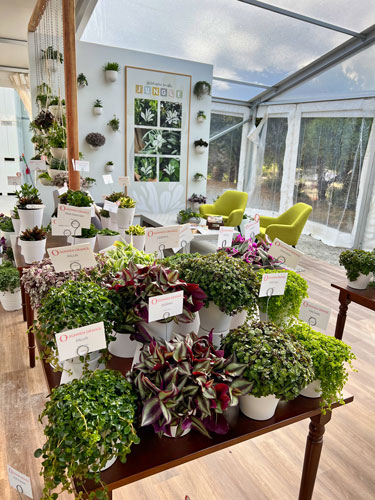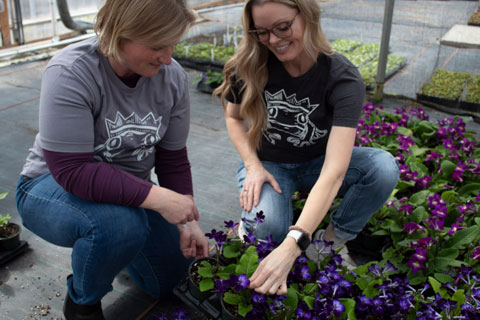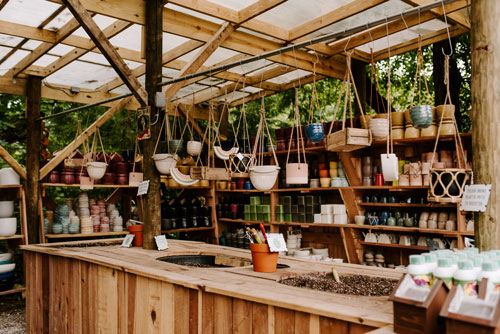5/1/2022
Houseplants Are Here to Stay
Jennifer Polanz

The houseplant market has been volatile for years now. A huge surge in demand coupled with supply difficulties and the time it takes to get houseplants to market converged to create a market that knows no bounds.
“Everything has been moving so fast and so rapidly, nobody knows what’s real in the marketplace because everyone is selling out,” says Austin Bryant at Heart of Florida Greenhouses, a wholesale foliage and tropicals supplier in Zolfo Springs, Florida. “We don’t know the top or the bottom.”
Pictured: Dümmen Orange’s new houseplant collection called Welcome to the Jungle that made its debut at California Spring Trials.
That volatility is starting to settle a bit, much to Austin’s relief. This year they’ve seen pot count increase a little over last year, but as a whole, the market seems to have plateaued. You don’t often see suppliers celebrating a plateau, but in this instance Austin says it was needed to right the ship, so to speak.
“Looking back over the last three to four years it’s been a real roller coaster,” he says. “To be honest, I’m happy to see the houseplant market plateau. We’ve been 18 to 24 months solid up—every market needs correction. We need to figure out what actual sales should be.”
Don’t be fooled by the word plateau, though. It doesn’t mean there’s something wrong with the market. In fact, it means it’s solidified its place as less fad and more here to stay. It’s been incredible the growth houseplants have seen since 2018 and it came on really fast from Millennials who adopted their “plant parent” designation wholeheartedly.
Jared Hughes, co-owner of Groovy Plants Ranch north of Columbus, Ohio, recalls an awful lot of hand-wringing at several events formerly known as Short Course and now called Cultivate (and, at the time, for good reason!). He mentions the SHIFT initiative with Columbus College of Art and Design (CCAD) to help drive engagement with Millennials.
“Current Millennials are allergic to plants, that’s what I remember from the study,” he says. “There’s been a national culture change … a culture shift on the way our products were received.”
Today he sees continued growth—enough to be able to buy 11 more acres and expand—and he’s doubled down with three to four greenhouses dedicated to tender plants such as succulents or houseplants. Groovy Plants Ranch has made a name for itself not just in the central Ohio area, but from even farther as they expand their reach through social media and ecommerce. Jared and his wife, Liz, have made the ranch a destination, not just for houseplants, but for all sorts of unique specimens that have a definite “cool factor.”
“They know what I have in stock before I know what I have in stock,” he says, laughing. “Whatever ice had to be broken to get them to be plant buyers was shattered two years ago.”
Growth Opportunities
I asked everyone I talked to what they’re seeing in demand right now and there are a couple of different answers. One is flowering plants for the indoors.
“We see blooming indoor plants as a growing trend: hoya, gloxinia, bromeliads and blooming cacti like epiphyllum,” says Joan Dudney, Marketing Manager for Little Prince of Oregon, a wholesale grower in Aurora, Oregon. “We also see a renewed interest in gesneriads (African Violet family) with plants like streptocarpus, streptocarpella and sinningia. We even see plant enthusiasts interested in coaxing blooms out of non-traditional ‘bloomers’ like tillandsia.”
 Pictured: Molly Molecki (left) and Joan Dudney (right) at Little Prince of Oregon take a look at pots of Streptocarpus Steffano’s Shadow Play.
Pictured: Molly Molecki (left) and Joan Dudney (right) at Little Prince of Oregon take a look at pots of Streptocarpus Steffano’s Shadow Play.
Jared added orchids to that list, noting that collectors enjoy amassing different types of orchids. He also felt succulents were going to make a bit of a comeback, now that the plant parents are a little more experienced.
“A lot of them started with succulents, failed and moved on to things like philodendrons. They want to try them again,” he says.
Austin is seeing continued popularity for peperomia, which is a really wide genera that encompasses a lot of options.
“There’s a wide variety of different ones,” he says. “I can set four in front of you and you would never think they were related.
“It’s kind of addictive—how many different ones can you get?”
Rare vs. Widely Available
When we talk rare plants, we’re talking in terms of mass availability at retail, not as in endangered in the environment (that’s an important distinction to make to the customer, too). I asked just how big a part of total sales is the rare plant market?
“I think the segment is rather small, but it’s what drives the larger segment,” Austin notes. “Not everybody can afford the $500 variegated Deliciosa Monstera.”
Jared says they try to have a good mix of both—the rare plants that drive traffic and interest, and the more widely available, affordable plants that someone can buy several of and not break the bank. What he’s observed, though, is the online plant swaps and ETSY sellers trade in cuttings and nodes, whereas customers can go to Groovy Plants Ranch for a full, healthy plant. It’s that distinction that sets them apart.
Joan and her colleague Molly Molecki, brand ambassador at Little Prince of Oregon, say they see continued demand for the long-standing houseplants like pothos and sansevieria, as well as growth on the rare side.
“Trends continue to shift with plants like fashion—highly influenced by social media and shifting quickly,” Molly says. “Rare plants often drive trends and overall demand, but become popularized quickly to their
detriment.
“Take for example Zamioculcas zamiifolia Raven or Philodendron Pink Princess, which quickly saturated social media and the market, driving down their value.”
Growing the Department
Because of the demand and the interest, it’s easy to expand the department with other plants that could also be houseplants. For example, Austin is working on some carex right now that have some unique textures and can take some abuse (an important characteristic for houseplants that get too much “love” in the way of watering and repotting from their plant parents). Heuchera could also fall into this. Last year, we dove into this with our cover story in the May issue because availability was so tight (we’ll talk more on availability in a minute).
 Pictured: Customers can pot up their new purchases or just shop for the perfect pot in the Potter’s Saloon at Groovy Plants Ranch north of Columbus, Ohio.
Pictured: Customers can pot up their new purchases or just shop for the perfect pot in the Potter’s Saloon at Groovy Plants Ranch north of Columbus, Ohio.
Creating more value with the plants you carry is another way to grow revenue from the houseplant department.
“As consumers become savvy about propagation and sourcing, growers will be held to increased ethical standards,” Molly says. “We use only beneficial organisms in our houseplant greenhouses. Our goal is to create a balanced ecosystem to control pests … we find that this creates a healthier plant, which is, frankly, what customers expect.”
Of course, along with increasing the value is providing the expert guidance new and existing customers need to be successful, she says, and offering an array of additional products like lighting, humidifiers, hard goods, pots and other accessories to support their houseplant habit.
Availability is Opening Up
As you may have discerned, availability is beginning to increase as suppliers have ramped up. Part of the issue with availability, though, is the “hot new ‘it’ plant” messaging that may drive interest, but also wreaks havoc on growers who need several months to get plants to market.
Take anthurium as a quick example. Austin says most 6-in. anthurium take between 10 to 11 months to grow. In order to hit the Valentine’s Day mark, he’s already ordered what he needs for next year.
“That’s why when these magazines put these things out “this is hot right now”—the cards are dealt. I either have it or I don’t.”
The best way to get consistent availability, too, is to buy consistently. If you only buy sporadically, the grower will be more likely sell to customers who produce orders more often.
There have been several new lines of houseplants announced recently, too, from companies like Proven Winners, Ball Horticultural Company, Monrovia and Dümmen Orange that will expand the availability in the market. Austin welcomes all of it, saying the more diverse the options, the healthier the market will be.
And while the health of the market is strong, it’s just as important to make sure the health of the plants is equally as strong to keep customers successful. Because availability had been an issue, plants were being shipped before they were ready and that’s something customers notice.
“Some days it feels like everyone is growing houseplants!” Joan says. “However, plant quality and grower practices are selling points that cannot be overlooked. All grower techniques are not equal.
“Buyers and consumers can easily spot a robust, healthy specimen and the demand for quality plants remains high.”
Final Takeaways
If you’re in houseplants, now is not the time to get out. It’s still going strong. If you haven’t jumped in yet, what are you waiting for? We may be close to the peak, but no one I talked to anticipated a strong downturn happening soon.
“Supply will rise to meet the demand,” Austin says. “We’re doing much better today in receiving what we want from what we ordered than a year ago. It’s night and day what we’re able to procure from liners than a year ago—it’s much better.
“We are around the bend of being able to produce a consistent supply. If you want to be in the houseplant industry you will have the opportunity to buy plants.”
Jared, meanwhile, isn’t too hung up on houseplants versus other plants—it’s one part of what they sell there.
“Houseplants are just a segment of plants and we sell plants. I like philodendrons and I like coralbells,” he says. “I think what’s important is we have a whole new generation of plant buyers. They’re primed and ready to be plant buyers, not just houseplant buyers.” GP